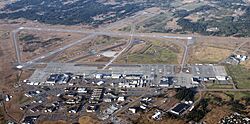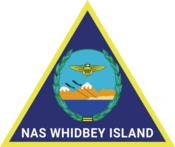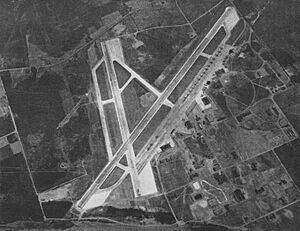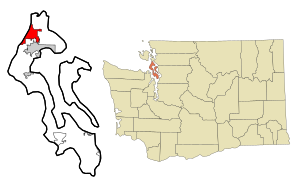Naval Air Station Whidbey Island facts for kids
Quick facts for kids Naval Air Station Whidbey Island |
|||||||||
|---|---|---|---|---|---|---|---|---|---|
| Ault Field | |||||||||
| Oak Harbor, Washington in the United States | |||||||||

An aerial view of NAS Whidbey Island
|
|||||||||
 |
|||||||||
|
Location in the United States
|
|||||||||
| Coordinates | 48°21′07″N 122°39′21″W / 48.35194°N 122.65583°W | ||||||||
| Type | Naval Air Station | ||||||||
| Site information | |||||||||
| Owner | Department of Defense | ||||||||
| Operator | US Navy | ||||||||
| Controlled by | Navy Region Northwest | ||||||||
| Condition | Operational | ||||||||
| Site history | |||||||||
| Built | 1942 | ||||||||
| In use | 1942 – present | ||||||||
| Garrison information | |||||||||
| Current commander |
Captain Eric Hanks | ||||||||
| Airfield information | |||||||||
| Identifiers | IATA: NUW, ICAO: KNUW, FAA LID: NUW, WMO: 690230 | ||||||||
| Elevation | 14.3 metres (47 ft) AMSL | ||||||||
|
|||||||||

Naval Air Station Whidbey Island (NASWI) is a major naval air station for the United States Navy. It is located on Whidbey Island in Washington, near Oak Harbor.
The base has two main parts. The first part is called Ault Field, which is about three miles north of Oak Harbor. The second part is known as the Seaplane Base. This area used to be home to PBY Catalina flying boats. Today, it has most of the Navy housing on the island. It also has the main Navy Exchange store and the DeCA Commissary.
The commanding officer of NASWI also oversees another airfield. This is the Naval Outlying Landing Field (NOLF) Coupeville. It's about nine miles south of Ault Field. This field is mostly used for practice landings by jets that fly from aircraft carriers. No permanent staff work there.
NASWI is home to several types of aircraft. These include the EA-18G Growler, MH-60S Seahawk, P-8 Poseidon, EP-3E ARIES, and C-40 Clipper.
Contents
History of NAS Whidbey Island
Starting in the 1940s
In 1941, before the United States joined World War II, the Navy looked for a place to refuel and re-arm its patrol planes. These planes were protecting Puget Sound. Many locations were considered, but Oak Harbor was chosen. It was a good spot for seaplanes to land and take off.
Work began quickly. By late 1941, they were dredging, filling land, and setting up water and power lines. Then, they decided they also needed a place for land planes.
On March 1, 1942, construction started on what would become Ault Field. This area was about four miles north of the seaplane base. The very first plane landed there on August 5, 1942. It was an SNJ trainer plane.
On September 21, 1942, the air station officially became a Navy facility. A year later, on September 25, 1943, the land plane field was named Ault Field. This was done to honor Commander William B. Ault. He went missing in action during the Battle of the Coral Sea in 1942.
Another auxiliary field, NOLF Coupeville, was approved in 1943. It was ready for use by September of that year.
During World War II, many planes were based at Ault Field. These included Grumman F4F Wildcats and Grumman F6F Hellcats. Later, Douglas SBD Dauntless dive-bombers became common. At the Seaplane Base, Consolidated PBY Catalina and Martin PBM Mariner seaplanes were used.
After World War II, things slowed down at the station. Many naval air stations closed. But NAS Whidbey Island stayed open because it met the new standards for runways and radar approaches. Lockheed P2V Neptune patrol bombers arrived in the late 1940s.
The 1950s: Korean War Boost
The Korean War brought NAS Whidbey Island back to full activity. The base expanded, and more construction took place. During the early 1950s, the main patrol aircraft was the Lockheed P2 Neptune.
Many Navy Reserve units were called to active duty during the war. By the end of the Korean War, six patrol squadrons and two support squadrons were based at Whidbey. In 1955, the first "heavy attack" squadron on the West Coast, VAH-2, was formed here.
The 1960s: Search and Rescue Begins
In early 1960, a search and rescue (SAR) team started at NAS Whidbey Island. They used Sikorsky HRS-2 helicopters. These helicopters were later replaced by HRS-3s. This SAR team was a trial at first, but it became a permanent part of the base.
In the mid-1960s, some patrol squadrons moved from NAS Whidbey. By the end of the decade, the Lockheed P-3 Orion began to replace the older Lockheed P-2 Neptune.
The 1970s: New Aircraft Arrive
On March 1, 1970, seaplane patrol operations ended at NAS Whidbey Island. This meant that Fleet Air Wing Four also ended. Only one Navy Reserve patrol squadron, VP-69, remained.
In the 1970s, NAS Whidbey Island became a major center for Grumman A-6 Intruder squadrons. These were all-weather attack planes. The base also became home to the Navy's first Northrop Grumman EA-6B Prowler squadron, VAQ-129. This squadron was the main training unit for Navy and United States Marine Corps Prowler crews.
The 1990s: More Squadrons Join
In the early 1990s, more Lockheed P-3 Orion patrol aircraft came to NAS Whidbey Island. This happened because other naval air stations were closing. In 1994, Fleet Air Reconnaissance Squadron ONE (VQ-1) also arrived. They flew Lockheed EP-3E Aries II aircraft.
In 1997, the last A-6E Intruder squadron based in the Pacific, VA-196, was deactivated.
The 2000s and 2010s: Modern Aircraft
In January 2009, VAQ-129 received its first Boeing EA-18G Growler aircraft. These new planes replaced the older EA-6Bs.
In October 2016, Patrol Squadron 4 (VP-4) became the first squadron at NAS Whidbey Island to switch to the P-8 Poseidon maritime patrol aircraft. A new training center for the P-8A also opened at the base on October 31, 2016.
NAS Whidbey Island Today
Today, NAS Whidbey Island is a busy place. It has 20 active duty U.S. Navy squadrons and three U.S. Navy Reserve squadrons.
The air station also has a special search and rescue (SAR) unit. This unit flies two Sikorsky MH-60S Nighthawk helicopters. They are ready 24 hours a day to help with rescues. They assist military personnel and the wider Pacific Northwest community. They can perform rescues over water, land, and in mountains.
More than 50 other commands are located at NAS Whidbey Island. These groups provide training, medical care, dental services, and other support. There is even a United States Air Force (USAF) squadron, the 390th ECS. This unit supports USAF officers who are assigned to Navy EA-18G Growler squadrons. The base continues to be an important center for Naval Air Reserve operations and training in the region.
Squadrons at NAS Whidbey Island
| Insignia | Squadron | Code | Callsign/Nickname | Assigned Aircraft | Operational Assignment | Administrative Assignment |
|---|---|---|---|---|---|---|
| Electronic Attack Squadron 129 | VAQ-129 | Vikings | EA-18G Growler | Fleet Replacement Squadron (FRS) | Commander, Electronic Attack Wing Pacific (COMVAQWINGPAC) | |
| Electronic Attack Squadron 130 | VAQ-130 | Zappers | EA-18G Growler | Carrier Air Wing Three | Commander, Electronic Attack Wing Pacific (COMVAQWINGPAC) | |
| Electronic Attack Squadron 131 | VAQ-131 | Lancers | EA-18G Growler | Forward/Expeditionary Deployments | Commander, Electronic Attack Wing Pacific (COMVAQWINGPAC) | |
| Electronic Attack Squadron 132 | VAQ-132 | Scorpions | EA-18G Growler | Forward/Expeditionary Deployments | Commander, Electronic Attack Wing Pacific (COMVAQWINGPAC) | |
| Electronic Attack Squadron 133 | VAQ-133 | Wizards | EA-18G Growler | Carrier Air Wing Nine | Commander, Electronic Attack Wing Pacific (COMVAQWINGPAC) | |
| Electronic Attack Squadron 134 | VAQ-134 | Garudas | EA-18G Growler | Forward/Expeditionary Deployments | Commander, Electronic Attack Wing Pacific (COMVAQWINGPAC) | |
| Electronic Attack Squadron 135 | VAQ-135 | Black Ravens | EA-18G Growler | Forward/Expeditionary Deployments | Commander, Electronic Attack Wing Pacific (COMVAQWINGPAC) | |
| Electronic Attack Squadron 136 | VAQ-136 | Gauntlets | EA-18G Growler | Carrier Air Wing Two | Commander, Electronic Attack Wing Pacific (COMVAQWINGPAC) | |
| Electronic Attack Squadron 137 | VAQ-137 | Rooks | EA-18G Growler | Carrier Air Wing Eleven | Commander, Electronic Attack Wing Pacific (COMVAQWINGPAC) | |
| Electronic Attack Squadron 138 | VAQ-138 | Yellowjackets | EA-18G Growler | Forward/Expeditionary Deployments | Commander, Electronic Attack Wing Pacific (COMVAQWINGPAC) | |
| Electronic Attack Squadron 139 | VAQ-139 | Cougars | EA-18G Growler | Carrier Air Wing Seventeen | Commander, Electronic Attack Wing Pacific (COMVAQWINGPAC) | |
| Electronic Attack Squadron 140 | VAQ-140 | Patriots | EA-18G Growler | Carrier Air Wing Seven | Commander, Electronic Attack Wing Pacific (COMVAQWINGPAC) | |
| Electronic Attack Squadron 142 | VAQ-142 | Grey Wolves | EA-18G Growler | Carrier Air Wing Eight | Commander, Electronic Attack Wing Pacific (COMVAQWINGPAC) | |
| Electronic Attack Squadron 144 | VAQ-144 | Main Battery | EA-18G Growler | Commander, Electronic Attack Wing Pacific (COMVAQWINGPAC) until move to Carrier Air Wing One | Commander, Electronic Attack Wing Pacific (COMVAQWINGPAC) | |
| Electronic Attack Squadron 209 | VAQ-209 | Star Warriors | EA-18G Growler | Commander, Tactical Support Wing (TSW) | Commander, Tactical Support Wing (TSW) | |
| USAF 390th Electronic Combat Squadron | 390th ECS | Wild Boars | EA-18G Growler | 366th Operations Group | 366th Fighter Wing | |
| Patrol Squadron 1 | VP-1 | Screaming Eagles | P-8A Poseidon | Commander, Patrol and Reconnaissance Wing Ten (COMPATRECONWING 10) | Commander, Patrol and Reconnaissance Wing Ten (COMPATRECONWING 10) | |
| Patrol Squadron 4 | VP-4 | Skinny Dragons | P-8A Poseidon | Commander, Patrol and Reconnaissance Wing Ten (COMPATRECONWING 10) | Commander, Patrol and Reconnaissance Wing Ten (COMPATRECONWING 10) | |
| Patrol Squadron 9 | VP-9 | Golden Eagles | P-8A Poseidon | Commander, Patrol and Reconnaissance Wing Ten (COMPATRECONWING 10) | Commander, Patrol and Reconnaissance Wing Ten (COMPATRECONWING 10) | |
| Unmanned Patrol Squadron 11 | VUP-11 | Proud Pegasus | MQ-4C Triton | Commander, Patrol and Reconnaissance Wing Ten (COMPATRECONWING 10) | Commander, Patrol and Reconnaissance Wing Ten (COMPATRECONWING 10) | |
| Patrol Squadron 40 | VP-40 | Fighting Marlins | P-8A Poseidon | Commander, Patrol and Reconnaissance Wing Ten (COMPATRECONWING 10) | Commander, Patrol and Reconnaissance Wing Ten (COMPATRECONWING 10) | |
| Patrol Squadron 46 | VP-46 | Grey Knights | P-8A Poseidon | Commander, Patrol and Reconnaissance Wing Ten (COMPATRECONWING 10) | Commander, Patrol and Reconnaissance Wing Ten (COMPATRECONWING 10) | |
| Patrol Squadron 47 | VP-47 | Golden Swordsmen | P-8A Poseidon | Commander, Patrol and Reconnaissance Wing Ten (COMPATRECONWING 10) | Commander, Patrol and Reconnaissance Wing Ten (COMPATRECONWING 10) | |
| Patrol Squadron 69 | VP-69 | Totems | P-8A Poseidon | Commander, Patrol and Reconnaissance Wing Ten (COMPATRECONWING 10) | Commander, Patrol and Reconnaissance Wing Ten (COMPATRECONWING 10) | |
| Tactical Operations Control Squadron 10 | TOCRON 10 | Kraken | Commander, Patrol and Reconnaissance Wing Ten (COMPATRECONWING 10) | Commander, Patrol and Reconnaissance Wing Ten (COMPATRECONWING 10) | ||
| Fleet Air Reconnaissance Squadron 1 | VQ-1 | World Watchers | EP-3E Aries II | Commander, Patrol and Reconnaissance Wing Ten (COMPATRECONWING 10) | Commander, Patrol and Reconnaissance Wing Ten (COMPATRECONWING 10) | |
| Fleet Logistics Support Squadron 61 | VR-61 | Islanders | C-40A Clipper | Commander, Fleet Logistics Support Wing (COMFLELOGSUPPWING) | Commander, Fleet Logistics Support Wing (COMFLELOGSUPPWING) | |
| Naval Air Station Whidbey Island Search and Rescue | NASWI SAR | MH-60S "Knighthawk" | Naval Air Station Whidbey Island (NASWI) | |||
| Electronic Attack Weapons School | EAWS | EA-18G Growler | Commander, Electronic Attack Wing Pacific (COMVAQWINGPAC) | Commander, Electronic Attack Wing Pacific (COMVAQWINGPAC) | ||
| Fleet Readiness Center Northwest | FRCNW | Naval Air Station Whidbey Island (NASWI) | Commander, Fleet Readiness Centers (COMFRC) |
Demographics
The area of Whidbey Island Station is also considered a census-designated place (CDP). In 2010, its population was 1,541 people. The total area of the CDP is about 17.2 square kilometers. A very small part of this area, about 0.05 square kilometers, is water.


































